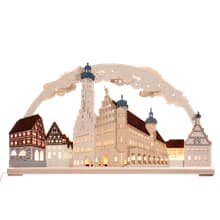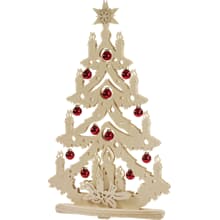Schwibbogen from the Erzgebirge - Christmas stories from everyday life
It has been a long winter in the "Miriquidi" (the dark forest of the Erzgebirge). But there was enough time for the miners to invent beautiful things for their children out of wood, ore or metal. Besides the nutcracker, miner and angel, incense smokers and other creations, the Erzgebirge folk art invented another form of representations made by hand. What, if not forest and snow, could represent the Erzgebirge more beautifully during Advent? From pragmatism and attention to detail developed Schwibbogen. To this day, they are part of that light that is sparse in the "dark season" in many regions.
Schwibbogen - a creative wooden arch for the Christmas season
Work in the mountain was gloomy and monotonous for ore mining employees at all times of the year. While they were laboriously cutting the ore out of the rock by hand, there was still time for creativity to look forward to Advent and Christmas. The template for such ideas was everyday life at any time of year. But also the work itself and rituals around mining provided the basis for the Erzgebirge folk art celebrated today.
A Schwibbogen represents architectural models in miniature. Viaducts, bridges and other structures in such arch form were already very load-bearing in historical times. Load-bearing capacity was also important for the miners in the Erzgebirge. This was the only way to ensure that they could leave the mine in one piece after their shift. Their longing to return home unharmed may have given rise to the first models of a candle arch.
For the form of the Schwibbogen from the Erzgebirge there are further conjectures. For example, the connection of the semicircle with the light could symbolize the visible (i.e. half) sky with its stars, the moon and the sun. More pragmatic is the assertion that Schwibbogen are based on the semicircle at the end of the tunnel. It was once the custom, at the end of the last mining shift, to release the workers into the winter break in the hem of a great festival of lights around the tunnel entrance and exit.
The idea for the Schwibbogen
A special feature is the appearance of candle arches. Their representations of home, figures or still life seem to float above the standing surface. The light of the candles reinforces this impression. Thus, this part of the Erzgebirge folk art combines everyday life and dreams in an artistic way. Only the materials have changed over time.
Originally, the miners made their Schwibbogen from metal. That made sense because at that time only wax was available for lighting. Candles and wood, however, did not get along well. So that the filigree Erzgebirge folk art did not pose a fire hazard, the ore that was salvaged anyway and the metal extracted from it offered themselves as a safe material.
The processing of metal was quite advanced in the Erzgebirge at an early stage. However, unlike other artistic figures for the Christmas season, the first candle arches appeared comparatively late. The first example of this miniature craft dates back to 1740, and wooden successors were created from the 19th century at the latest. In the 21st century, wooden candle arches are finely fret worked. Because with electric lighting there is no fire risk for the small window decoration of the Advent season.
Why the semicircle?
In architectural constructions, similarly shaped arches connect parts of walls or houses. The arch shape is more load-bearing there than an angular structure. Visually, architects have also thought up this shape for optical reasons. Round, semicircular or just somehow not angular shapes suggest a kind of floating. This literally closed the circle between craftsmanship and pragmatism. A candle arch in its original form also wants to convey something spherical, that is, floating.
For the miners in the tunnels, Erzgebirge folk art was almost the only chance, especially in winter, to deal with their hard everyday life in a playful rather than physically strenuous way. Some say that the miners associated the last shift before Christmas with the greatest joy of the winter in the Erzgebirge. Others claim that religious assumptions gave the Schwibbögen their shape of half the arch of heaven.
Especially in winter, soft rather than angular shapes are more popular even today. Without a religious context, they form a pleasant contrast to the rugged and dark season. Also, the light with which they are staged is visually "softer" in the semicircle and thus at least for the soul a blessing. The semicircle of a candle arch will therefore remain for a very long time trend among the most popular products that the Erzgebirge folk art has to offer.
The reason for the light on Schwibbogen
The first Schwibbogen were initially made of metal due to bad experience with wood. Although it became hot when the candle burned down on it. At the same time, however, its nature prevented the material from igniting under the candles. Wood for manufactures knew the Erzgebirge folk art much longer. But mishaps with incense burners apparently kept the inventors of the Schwibbogen from using wood as the basis for Christmas lighting.
The Erzgebirge in itself was a truly sinister place in historical times. Travelers and locals referred to the region as "Miriquidi" even in summer. The name stood for a dark stretch of land through which sun and warmth could penetrate only with difficulty. Those who lived there perceived their environment as equally dark and impenetrable. With Schwibbogen they came closer to their idea of warmth and light, at least artistically.
The half-arch of Schwibbogen has advantages. Lights can be distributed on it according to religious or individual rules. The shape, open to the front and back, allows them to be placed even on narrow window sills. Nevertheless, the shaped figures have a three-dimensional effect. Thus, the light on and on Schwibbogen creates the Christmas image of landscapes, everyday scenes or similar artistic realizations.
Why on the windowsill?
Always in Advent people decorate their home with artificial figures of different texture. The Advent wreath is round, the nutcracker high. The stars in the sky and the Christmas tree in the living room testify to the hope of new life and patience beyond winter. The tradition of placing illuminated candle arches on the windowsill is older than the motif art itself.
Originally, Christian households had a lit candle in the window during Advent. Like-minded people recognized that they could meet fellow believers here.
The Erzgebirge folk art has developed from this old tradition the richly decorated semicircle with much more than a single candle. It is simply good for the soul to know that a light in the window helps to get over the otherwise "dark season" in winter. The choice of location is also somewhat pragmatic. After all, the Advent lights are already burning on the table in the living room. The narrow shape in depth complements this cozy light perfectly on the narrow ledge between the heated interior and the harsh outside world.
The temperature extremes in the historic Erzgebirge may also be a reason for the Schwibbogen's present location. Outside, snow and frost had a firm grip on the landscape. Inside, residents hoped for a little more view between snow flowers and window frames. The burning of the Schwibbogen in the evening could well keep a small window thawed overnight. But more important than the view was the sight for passers-by. Because they saw another sign of confidence, fantasy and dreaming since the invention of this Erzgebirge craft. Modern variations oft he Schwibbogen
The theme of all Schwibbogen since their invention in metal is the everyday life of people, animals and fairy tale characters in the Ore Mountains. Especially the "honorable profession" of the miner was symbolically represented in the first metal designs. But long ago the ore mining in such a way is history. So the Erzgebirge folk art resorts to other ideas in this art form.
Now, fretwork and plywood can be used to create much more filigree window pictures. Christmas in places of historical manufactories, winter idyll with deer and children or dreamed encounters between people and winter fairy tales (Santa Claus, snowman or elf) are now designed in great detail.
The fire risk of a Schwibbogen with its many lights at different heights is also eradicated. Modern variations illuminate windows and parlor with energy-saving LED light instead of candles. The color of the light is reminiscent of its historical predecessors. Also, the original half-arch in the same floating look is replaced by pyramid shapes, tree shapes and other mini-architectures. Although the Schwibbogen was originally made of pewter or silver, it has now been overtaken by the trend of wooden handicrafts. In terms of beauty, all material variants can well measure up to each other.
Conclusion:
Schwibbogen arrived late in the Erzgebirge folk art among all inventions from the Miriquidi. They were first made of pewter or silver and symbolically reflected the profession of miners from the Erzgebirge. Nowadays, candle arches belong on windowsills all over the world and tend to be made of plywood or wood. They are now illuminated with harmless LED light and thus no longer pose a fire hazard during Advent.













